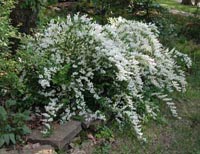Resource Library
Plant of the Week: Slender Deutzia
The University of Arkansas System Division of Agriculture does not promote, support or recommend plants featured in "Plant of the Week." Please consult your local Extension office for plants suitable for your region.
Plant of the Week
Slender Deutzia
Latin: Deutzia gracilis

Garden books often speak of "the shrub border" as if everyone were an estate gardener with unlimited space and resources. When my wife wins the long-promised Publishers Clearinghouse prize, maybe there will be more room, but until then sunny spaces must be guarded jealously.
Slender deutzia (Deutzia gracilis), though, is an exceptional deciduous shrub that has earned a spot in the springtime lineup in my garden.
Slender deutzia is the best of the many kinds of deutzias that can be grown. It’s a gracefully arching, 3-foot tall and wide shrub covered with sprays of white flowers in mid spring. The plant form is mounded with a topknot of loose, ascending branches held above the foliage. The epitaph name translates as "slender" and is a reference to the thin branches.
The medium green leaves are 2 1/2 inches long and a half-inch wide and give the shrub an effective, but unremarkable summertime appearance. There is no fall color.
Pure white flowers are borne in profusion in early May in loose, 4-inch long panicles. The panicles are produced from each node on the arching stem. Individual blossoms have five petals and are slightly fragrant. Though they have little outward resemblance, deutzias are a member of the hydrangea family.
Mike Dirr, the eminent Georgia plantsman and garden authority, doesn’t like deutzias much. His argument against them is that they have only one season of interest. The flowers are beautiful, but last for only two weeks and then are gone. But, oh what a glorious two weeks. Dirr does admit that of the 60 or so species of deutzia, the slender deutzia is probably the best.
But I suspect that frustration may also be behind some of his bias against these shrubs.
They’re a mess taxonomically, almost impossible to accurately identify and hopelessly
confused in the nursery trade. Any author wishing to make sense of the group
must harbor some animosity for all the confusion they cause.
My slender deutzias were bought tagged with the cultivar name ‘Nikko’, a groundcover form with trailing branches said to be less than 2-feet tall. It quickly became apparent that the plants were mislabeled and were just the ordinary species. I have since acquired ‘Nikko’ and am glad for the error, because this dwarf form lacks the gracefully arching branches of the species.
Errors creep into plant naming at every level. If propagators misidentify a plant when they collect cuttings, the mistake will stay with the plant throughout the production cycle. Because most nurserymen never grow their plants long enough to see the mature form, errors in naming can go on for years.
Another way that differences can creep into the system is when plants take on a different form depending on the position from which the cuttings are collected. This phenomenon even has a name - topophysis. Not all plants show the characteristic and I’m not sure of it occurs in deutzia, but it can affect the form of the mature plant.
The most common change seen is a change from spreading to ascending or visa versa. In many plants, cuttings taken from upright growing branches produce plants with an upright habit. Cuttings made from side branches with a trailing habit usually grow more horizontally. That could be the cause of my mislabeled deutzia, but then one should never rule out incompetence.
Slender deutzia is an easy to grow shrub. I have two plantings, one in about six
hours of sun and the other in the shade of trees but exposed to good skylight conditions.
The more shaded plant is a bit more open, but flowers as well as the plant in better
light.
After flowering the plants are "bunch cut pruned." I gather a handful of branches and lop off some of the arching branches; allowing new shoots to grow that will form the display next spring. I have had no insect or disease problems.
By: Gerald Klingaman, retired
Extension Horticulturist - Ornamentals
Extension News - May 13, 2005
The University of Arkansas System Division of Agriculture does not maintain lists of retail outlets where these plants can be purchased. Please check your local nursery or other retail outlets to ask about the availability of these plants for your growing area.